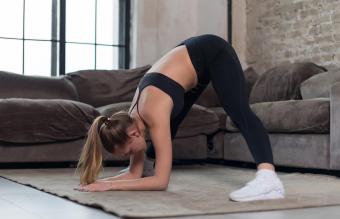
Close your eyes and picture a person meditating. You probably thought of a person sitting with their legs crossed and their eyes closed. Maybe you even pictured their palms faced upwards with their thumb and forefinger drawn together to form a variation of the "OK" symbol. This hand shape is an example of a yoga mudra.
A mudra is a symbolic hand gesture or body movement used in various dances and rituals of Hinduism, Buddhism, and Jainism which are believed to help energy flow throughout the body. Some of the most popular mudras are used in yoga and meditation practices. Pran mudra, also called prana mudra, represents life force energy and is believed to stimulate the root chakra and have several healing benefits.

Prana Mudra Benefits
In Sanskrit, "prana" means life force energy, and "mudra" translates to gesture or mark. Combined, the words show that this specific hand position is geared towards stimulating the levels of energy in the body. In fact, it is often referred to as the healing mudra because it has these qualities.
It is believed that there are over 400 different types of mudras across various religious and spiritual practices, and each has unique healing effects on both the body and mind. The pran mudra, also called pitta-naashak mudra or kapha kaarak mudra, has been linked to the root chakra in the body, which is situated at the base of the spine. This means that not only can the mudra increase the flow of energy throughout the body, but it can also improve health aspects related to that specific chakra.
Some health benefits associated with the pran mudra and stimulating the root chakra include:
- Boosts energy and decreases fatigue
- Creates a greater sense of connection to the self and others
- Fosters a stronger sense of belonging
- Improves sleep quality
- Increases feelings of groundedness and focus
- Stimulates the immune system
How to Perform the Pran Mudra
Performing this mudra is fairly simple in action. You can practice the gesture by using it whenever you decide to take a few deep breaths during the day. However, you can also practice it alongside a yoga flow or a guided meditation if you were hoping to flex your concentration muscles just a bit more.
Follow the instructions below to begin your pran mudra practice:
- Sit comfortably with your back straight. You can do this sitting down with your legs folded beneath you, or practice in a chair with your feet gently resting on the floor. If you prefer, you can even practice this mudra lying down with your palms facing upwards.
- Then, bring the tips of your thumb, pinky, and ring finger together to touch.
- Extend the index finger and middle finger straight out so that they are pointing forward.
- Do this with both hands, and then place them in your lap with your palms facing upwards.
Try and hold the mudra for about three to five minutes. You can work on extending the amount of time you sit with the mudra over time. And, if you feel comfortable, you can include it in your meditation, yoga, or stretching practices.
Tips to Enhance Your Mudra Practice
If you're new to mudras, yoga, or meditation, don't worry. You can still try out the pran mudra and see if you experience any positive changes to your overall well-being. If it takes you a while to get the hang of it, that's okay. You're trying something new and everyone has to start somewhere.
Consider the following tips to increase the power of the prana mudra.
- Use the Bija mantra for the chakra. These mantras are sounds or chants that are believed to increase the power of the mudra. For the root chakra, the Bija mantra is "Lam," (pronounced lahm). Slowly repeat this sound out loud while you practice the hand gesture.
- Try and hold the mudra for as long as you can to increase the amount of time you have with the practice. You might also be able to incorporate it into your daily routine when possible.
- You can also visualize the color red while you practice the mudra, as this color is associated with the root chakra.
- Take breaks when you need to. If you set a goal to meditate or practiced the mudra for 15 minutes, but start to notice that you lose your concentration after ten minutes, that's okay. You can always return to the practice later in the day and try again for the remaining five minutes of your goal and gradually work your way up.
If you already have an established yoga or meditation practice, you can seamlessly incorporate the pran mudra into your current routines. However, if you're new to these practices, or just want to add a little extra helping of self-care to your daily life, you can practice prana mudra just by allowing your body and mind to rest and taking deep breaths. The more your practice, the more you may begin to feel balanced and energized.







